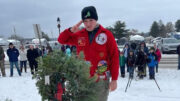In the lull after the holidays, stop and take a few minutes to assess the successes, challenges, and disappointments of the past growing season. Evaluating your garden now will save you time, money, and frustration next spring. I will show you how to analyze for needed changes. We will consider why plants die and how to avoid future problems.
How to Evaluate What Worked and What Didn’t
By looking at photographs, referring to my garden journal, and strolling through my austere December gardens, I jog my memory to review the recent growing season. It is important to take notes as you consider the following questions:
Did family members like specific varieties of vegetables?
Did certain vegetable varieties take up too much space?
What vegetables failed and why? Insects? Disease?
Which flowers did particularly well this year?
Which flowers failed?
Did some flowers require more watering?
Which plants need to be divided?
Which plants should be moved to a better spot?
What task was too time-consuming?
Is the lawn too much to maintain in time and cost?
Have some shrubs or trees grown too close together?
Write down your answers because it’s a long time until next spring. Nothing fancy is needed; just make a list with notes and thoughts about what you liked and didn’t like this summer.
Planning Needed Changes
Plan to make changes next spring based on your answers to the list of questions. Begin with the soil; the foundation of all your plant growth. If you haven’t done a soil test for a couple of years, aim to purchase a kit from your local Extension office. A soil test will reveal if fertility is low, if acidity has dropped (so you need to add lime), or if there is too much phosphorous in your soil, for example. The soil test report will indicate what you need to do. Next, consider the various sections of your yard:
1. Vegetables: Next spring, you will want to plant those vegetables with flavor, disease resistance, and performance as noted in your evaluation. For example, you probably grew more than one type of tomato; repeat the one that grew well and tasted so good. See where problems like insects, diseases, and weeds occurred and make sure to plant next year’s crops in different locations. In a small garden, finding a different spot for the nightshade family plants (tomatoes and eggplants) can be tricky but is essential. Crop rotation can reduce many of your vegetable troubles.
2. Flowerbeds: Plants fail or die when they lack two key essentials: suitable growing requirements and the right growing conditions. If only one specific type of plant had a problem it may be due to the wrong growing requirements causing insects or diseases to attack. The plant may be located in the wrong spot or is not adapted to the climate. If most of the plants in a flowerbed were affected, they probably did not have the correct growing conditions. Growing conditions include soil, available light, watering, and the weather. Often flowers and vegetables fail because they don’t have enough sun. Choose shade-tolerant plants instead. Flowers are as particular about their water needs as they are about sun exposure. Read your plant’s care tag to learn about its irrigation requirements. Plant together those flowers with similar needs.
3. Shrubs and Trees: Shrubs and trees that are planted too close to each other may have grown together. If that has happened, you may need to remove some or cut them out. This often occurs with foundation plantings that obscure windows. If some shrubs, such as forsythia and lilacs, have grown too large you can prune them back to the ground, or remove a third of the older branches each year. You may want to thin out tree branches to create more light, or you may replace the plants under them with shade lovers, especially if they are tall and leggy.
4. Lawn: If you want to mow less, consider removing some of your lawn. Use massed plantings of groundcovers, especially under trees. Consider mowing an area of the lawn only once or twice a year. Define the edges and maintain the lawn around the ‘natural zone’ to prevent a weedy look. Natural areas are best for beneficial insects and pollinators.
Pests and Diseases
If powdery mildew affected plants such as phlox and bee balm, plan to thin them in the spring to increase air circulation. Proper spacing reduces the risk of disease and increases your plants’ health and beauty. Move struggling plants to a location that better meets their needs. Placing the right plant in the right place goes a long way to ensuring better success. If deer have become a problem, decide if you can just add some deterrents such as sprays, or if you need to put up a fence barrier.
The Weather
Snow is becoming less frequent across Pennsylvania due to the climate-change challenges that we are facing. Because we had very little snow cover during last year’s winter months, I lost some perennials. Snow has an insulating effect. It helps protect plantings from alternating freezing and thawing cycles. Without snow, milder temperatures and the sun warms the soil surface, leading to damage from soil heaving, which can break roots and dry out plant parts. It is important to mulch your beds in the event of decreasing snow cover. Evergreen branches from the used Christmas tree are a good material choice. Straw is another suitable option. Mulches may be applied over existing snow. Mulches also help in the summer by keeping the soil cooler when heat and humidity stress many kinds of plants.
The Gardener
As you evaluate your garden you may feel you need to cut back due to a busy work schedule, a new baby, or less physical energy as you age. Focus on main interests and key areas. Chose low-maintenance plants like shrubs, quality spring bulbs, and native plants. Emphasize foliage to cut down on blooms that need deadheading. Try container gardening or raised beds that are usually easier to maintain than large gardens. Think ‘simple,’ for example, using one plant to make a large impact.
The Environment
Finally, look for ways to improve the environment by decreasing water and pesticide use. Consider adding a water barrel to collect rainwater. Resolve not to burn your young transplants with excessive fertilizers.
It’s never too early to start dreaming about and planning for the spring. Doing an honest evaluation of this year’s efforts will go a long way to ensuring a successful growing season next year.
By Pamela T. Hubbard, Master Gardener, Penn State Extension, Monroe County
This educational blog is a series of informative articles from the Penn State Master Gardeners volunteers plus news concerning the group and their activities. For more information, click here.


































